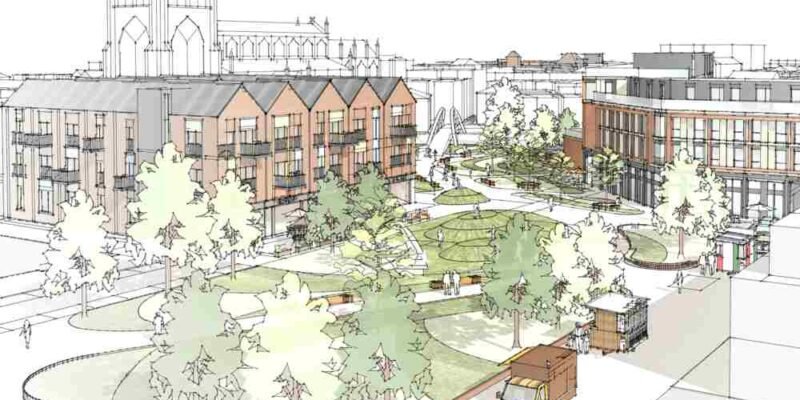Urban regeneration projects can significantly influence property prices, revitalize areas, and boost the local economy. Property experts, including estate agents in London, agree that understanding the effects of such projects on property values can help homeowners, buyers, and investors make informed decisions. This guide explores the various impacts of urban regeneration on property prices.
Understanding Urban Regeneration
Definition
Urban regeneration involves the redevelopment and revitalization of urban areas that have experienced decline. This process often includes improvements to infrastructure, housing, public spaces, and amenities.
Goals
- Economic Revitalization: Stimulating economic activity and job creation.
- Social Benefits: Improving living conditions, reducing crime, and enhancing community cohesion.
- Environmental Improvements: Promoting sustainable development and green spaces.
Positive Impacts on Property Prices
Improved Infrastructure
Transport Links
- Enhanced Connectivity: New or improved transport links, such as roads, railways, and public transit, make areas more accessible and attractive to buyers.
- Increased Demand: Better connectivity often leads to increased demand for properties, driving up prices.
Utilities and Services
- Upgraded Utilities: Improvements to water, sewage, and electrical systems enhance the livability of an area, making properties more desirable.
- Access to Services: Enhanced access to healthcare, education, and recreational facilities boost property values.
Housing Developments
New Housing
- Modern Homes: The construction of new, modern housing can attract buyers looking for contemporary amenities and design.
- Diverse Options: Offering a range of housing options, from affordable to luxury, can cater to different market segments.
Renovation of Existing Properties
- Restoration Projects: Renovating and restoring older buildings can preserve cultural heritage while providing updated living spaces.
- Increased Appeal: Well-renovated properties can significantly enhance the visual appeal and value of an area.
Economic Growth
Job Creation
- Employment Opportunities: Urban regeneration projects often lead to job creation in construction, retail, and services, attracting workers and boosting demand for housing.
- Business Investments: New businesses and commercial developments increase economic activity and can lead to higher property prices.
Increased Disposable Income
- Higher Incomes: Economic growth and job creation can lead to higher disposable incomes, enabling more people to afford property purchases.
- Retail and Entertainment: The development of shopping centers, restaurants, and entertainment venues makes areas more attractive and increases property values.
Social and Environmental Enhancements
Green Spaces
- Parks and Recreational Areas: The creation or enhancement of parks and recreational areas improves the quality of life and attracts buyers looking for outdoor amenities.
- Environmental Sustainability: Sustainable development practices can make areas more attractive to environmentally conscious buyers.
Community Services
- Schools and Healthcare: Improved access to quality schools and healthcare facilities makes areas more desirable for families, driving up property prices.
- Safety and Security: Reduced crime rates and enhanced safety measures increase the attractiveness of regenerated areas.
Potential Negative Impacts
Gentrification
Displacement of Residents
- Rising Costs: Increased property prices can lead to higher living costs, potentially displacing long-term, lower-income residents.
- Community Changes: The influx of new, wealthier residents can alter the social fabric of a community, leading to potential tensions.
Affordable Housing Shortage
- Lack of Affordable Options: Urban regeneration projects may focus on luxury developments, reducing the availability of affordable housing.
- Policy Considerations: Ensuring that regeneration projects include affordable housing options is crucial to maintaining community diversity.
Short-Term Disruption
Construction Activity
- Noise and Pollution: Ongoing construction can lead to increased noise, dust, and pollution, temporarily reducing an area’s attractiveness.
- Traffic Congestion: Roadworks and construction-related traffic can cause congestion and inconvenience.
Market Volatility
- Price Fluctuations: The initial phases of regeneration projects can lead to market volatility, with property prices fluctuating based on perceived future value.
- Speculation: Increased speculation can drive up prices artificially, leading to potential market corrections later.
Long-Term Benefits
Sustainable Growth
Steady Appreciation
- Gradual Value Increase: Regenerated areas often experience steady property value appreciation over the long term as infrastructure and amenities continue to improve.
- Investment Stability: Long-term investments in regenerated areas can offer stable returns as the area develops.
Enhanced Quality of Life
Community Cohesion
- Stronger Communities: Improved living conditions and amenities can lead to more robust, more cohesive communities.
- Cultural Preservation: Regeneration projects that preserve cultural and historical aspects of an area can enhance its unique character.
Environmental Benefits
- Sustainable Practices: Incorporating sustainable development practices can lead to long-term environmental benefits and increased property values.
- Health and well-being: Improved green spaces and reduced pollution contribute to better health and well-being for residents.
Case Studies and Examples
Successful Urban Regeneration Projects
London Docklands
The London Docklands project was an overnight makeover that turned an area of neglect into a flourishing district for commercial and residential use.
- Property Values: Due to better infrastructure, amenities, and commercial improvements, property values have significantly increased.
Manchester’s Northern Quarter
The renewed Manchester’s Northern Quarter has become a bustling cultural and creative hub.
- Attraction: The area is now inhabited by young professionals and creatives, raising demand and property prices.
Lessons Learned
Comprehensive Planning
- Inclusive Development: Ensuring that regeneration projects include adequate housing and community services can mitigate negative social impacts.
- Long-Term Vision: Be guided by a long-term vision towards benefits and goals that create growth and success.
Community Involvement
- Stakeholder Participation: Involving local communities in the planning and decision-making process ensures that their needs are considered in regeneration projects.
- Transparency: Maintaining transparency throughout the entire regeneration process builds trust and community support.
Conclusion
Urban regeneration holds several promising positives, from infrastructure improvements to economic growth and better lives. The negative impacts, such as gentrification and short-term upheaval, can be minimal if managed well. Understanding the intricacies of urban regeneration is critical for stakeholders to maximize the benefits and contribute to creating thriving and sustainable societies. Whether you’re a real estate consumer or an investor, being aware of the urban regeneration projects in your area is crucial for making informed decisions.
Do Read: How Blockchain is Transforming Real Estate in Cyprus: Key Insights from Soneverse













